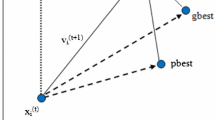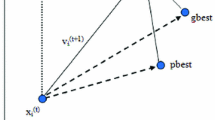Abstract
The present paper focuses on the suppression of background noise in speech signal by utilizing a powerful heuristic optimization algorithm called Bat algorithm (BA) for adaptive filtering in dual channel enhancement systems. Bat algorithm is a recently developed population based meta heuristic approach which is inspired by the hunting behavior of the bats. It is developed by Yang (2010). As a novel feature Bat algorithm is based on the echo location behavior of micro bats. BA uses the frequency tuning technique to increase the diversity of the solutions in the population, while at the same time it uses the automatic zooming and tries to balance the exploration and exploitation. A few studies have been carried out on the use of heuristics for ANC in speech enhancement by using standard particle swarm optimization (SPSO) and some of its variants till 2010. In order to extend these heuristic approaches to speech, accelerated particle swarm optimization (APSO) based enhancement approach has been proposed (Prajna et al. in Int J Speech Technol 17(4):341–351, 2014a; Prajna et al. in IJISA 6(4):1–10, 2014b, doi:10.5815/ijisa.2014.04.01; Prajna et al. in IEEE international conference on communications and signal processing (ICCSP), April 2014, pp 1457–1461, 2014c, doi:10.1109/ICCSP.2014.6950090). To overcome the problem of poor exploitation ability of APSO, another approach is proposed based on gravitational search algorithm (GSA) (Prajna et al. 2014a, b, c). To combine both the abilities of PSO and GSA algorithms, Hybrid PSOGSA algorithm is also proposed to ANC (Prajna et al. 2014a, b, c). To further improve the efficiency of adaptive filtering in ANC, by providing a dynamic balance between exploration and exploitation, BA is proposed to speech enhancement. This paper intends to present the Bat algorithm as an improved approach to ANC in speech enhancement when compared with that of SPSO, APSO, GSA and Hybrid PSOGSA based speech enhancement algorithms. The performance of all the algorithms is evaluated by computing four objective measures SNRI, PESQ, FAI and WSS, in two real world noise conditions Babble and Factory, at three different input SNR levels set at −10, 0 and 5 dB. Simulation results prove that BA is the most successful algorithm of all the algorithms studied in this work, to suppress the background noise more effectively.











Similar content being viewed by others
References
Asl, L. B., & Geravanchizadeh, M. (2010a). Dual-channel speech enhancement based on stochastic optimization strategies. In International conference on information science, signal processing and their applications, 2010, pp. 229–232.
Asl, L. B., & Geravanchizadeh, M. (2010b). Asexual reproduction based adaptive quantum particle swarm optimization algorithm for dual channel speech enhancement. In International conference on information science, signal processing and their applications (ISSPA 2010), pp 129–132.
Asl, L. B., & Nezhad, V. M. (2010a). Speech enhancement using Particle swarm optimization Techniques. In International conference on measuring technology and mechatronics automation, 2010, pp. 441–444.
Asl, L. B., & Nezhad, V. M. (2010b). Improved particle swarm optimization for dual-channel speech enhancement. In International conference on signal acquisition and processing, 2010, pp. 13–17.
Eberhart, R. C., & Kennady, J. (1995). A new optimizer using particles swarm theory. In International symposium on micro machine and human science, Nagoya, Japan, pp. 39–43.
Goodwin, G., & Sin, K. (1985). Adaptive filtering prediction and control. Englewood Cliffs, NJ: Prentice-Hall.
http://www.speech.cs.cmu.edu/comp.speech/Section1/Data/noisex.html.
Hu, Y., & Loizou, P. (2006). Subjective comparison of speech enhancement algorithms. In ICASSP proceedings, Toulouse, France, pp 153–156.
Klatt, D. (1982). Prediction of perceived phonetic distance from critical band spectra. In Proceedings of IEEE international conference acoustics, speech, signal process, Vol. 7, pp. 1278–1281.
Krishnamoorthy, P. (2011). An overview of subjective and objective quality measures for noisy speech enhancement algorithms. IETE Technical Review, 28, 292–301.
Kunche, P., Rao, G. S. B., Reddy, K. V. V. S., & Maheswari, R. U. (2014). A new approach to dual channel speech enhancement based on hybrid PSOGSA. International Journal of Speech Technology, 18(1), 45–56.
Lim, J. S., & Oppenheim, A. V. (1979). Enhancement and band width compression of noisy speech. Proceedings of the IEEE, 67(12), 1586–1604. doi:10.1109/PROC.1979.11540.
Loizou, P. C. (2007). Speech enhancement theory and practice. Boca Raton: CRC Press.
Loizou, P. C., & Ma, J. (2011). Extending the articulation index to account for non-linear distortions introduced by noise-suppression algorithms. The Journal of the Acoustical Society of America, 130(2), 986–995.
Mirjalili, S., & Mohd Hashim, S. Z. (2010). A new hybrid PSOGSA algorithm for function optimization. In IEEE international conference on computer and information application (ICCIA 2010), 2010, pp. 374–377.
Osgouei, S. G., & Geravan Chizadeh, M. (2010). Dual-channel speech enhancement based on a hybrid particle swarm optimization algorithm. In 5th international symposium on telecommunications (IST’ 2010), pp. 873–877.
Prajna, K., Rao, G. S. B., Reddy, K. V. V. S., & Maheswari, R. U. (2014a). A new approach to dual channel speech enhancement based on GSA. International Journal of Speech Technology, 17(4), 341–351.
Prajna, K., Sasi Bhushan Rao, G., Reddy, K. V. V. S., & Maheswari, R. U. (2014b). A new dual channel speech enhancement approach based on accelerated particle swarm optimization (APSO). IJISA, 6(4), 1–10. doi:10.5815/ijisa.2014.04.01.
Prajna, K., Rao, G. S. B., Reddy, K. V. V. S, & Maheswari R. U. (2014c). Application of Bat algorithm in dual channel speech enhancement. In IEEE International conference on communications and signal processing (ICCSP), April 2014, pp. 1457–1461. doi:10.1109/ICCSP.2014.6950090.
Rashedi, E., Nezamabadi-Pour, H., & Saryazdi, S. (2009). GSA: A gravitational search algorithm. Information Science, 179(13), 2232–2248.
Ueda, T., & Suzuki, H. (1990). Performance of equalizers employing a re-training RLS algorithm for digital mobile radio communications. In 40th IEEE vehicular technology conference, 1990, pp. 553–558.
Widrow, B., & Stearns, S. (1985). Adaptive signal processing. Englewood Cliffs, NJ: Prentice Hall.
Yang, X. S. (2010). Nature-inspired metaheuristic algorithms (2nd edn.). Luniver Press.
Author information
Authors and Affiliations
Corresponding author
Rights and permissions
About this article
Cite this article
Prajna, K., Reddy, K.V.V.S., Rao, G.S.B. et al. A comparative study of BA, APSO, GSA, hybrid PSOGSA and SPSO in dual channel speech enhancement. Int J Speech Technol 18, 663–671 (2015). https://doi.org/10.1007/s10772-015-9308-2
Received:
Accepted:
Published:
Issue Date:
DOI: https://doi.org/10.1007/s10772-015-9308-2




